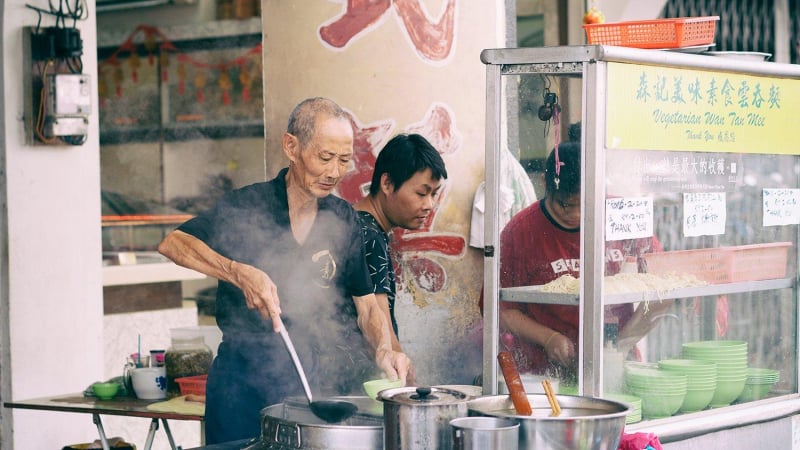Bat Trang pottery village, with a history of about six centuries, is not only famous for its sophisticated ceramic products bearing a strong cultural and spiritual imprint, but is also known as one of the unique "culinary cradles" of Hanoi. Here, Bat Trang dishes have become a culinary symbol, preserving and promoting unique features over hundreds of years, imbued with the traditional flavors and quintessence of the capital.
In recent days, a heated debate has broken out in the community about the value of Bat Trang trays - an indispensable part of Hanoi's culinary culture. The focus of the debate lies in the price, which is usually not less than two million VND for a full tray. Some opinions say that this price is too high, not commensurate with the actual value. However, many people have spoken up to "clear their name", firmly affirming that this expensiveness is completely justified by the quality of fresh ingredients, the meticulousness in processing and above all, the unique, delicate flavor that Bat Trang trays bring, which has been cultivated and preserved through many generations.
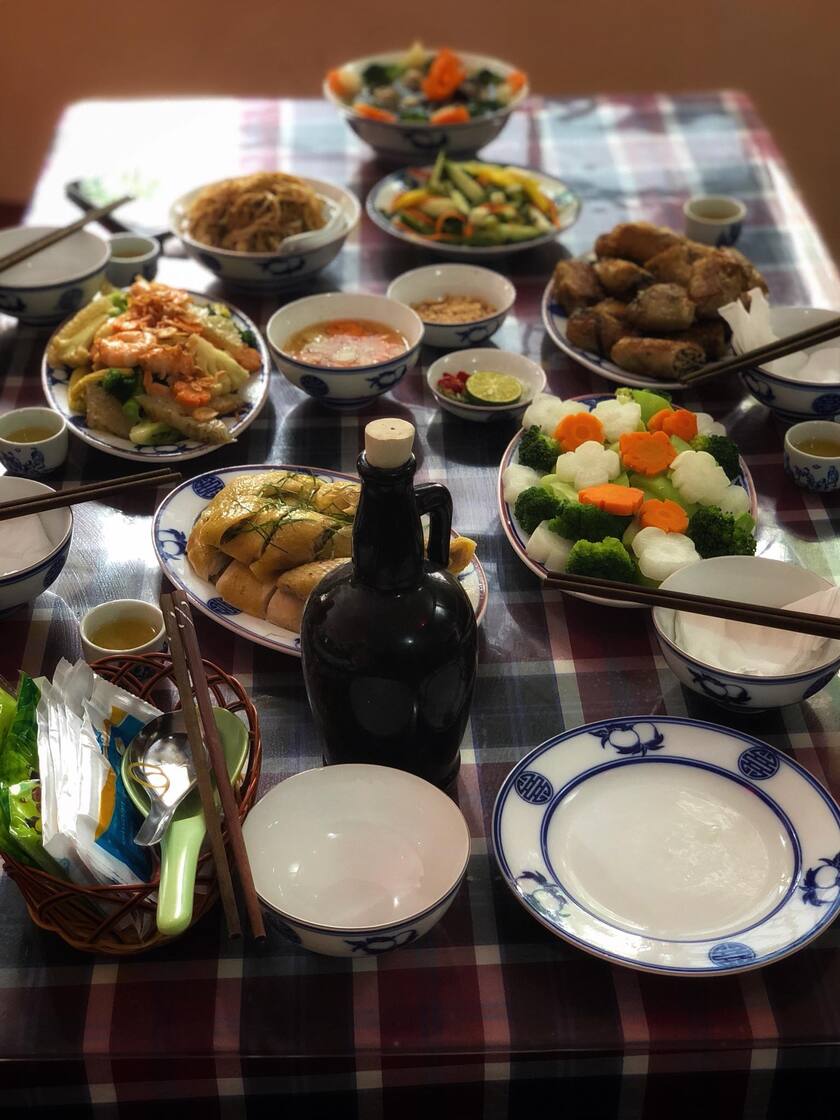
“Memory and culture are needed for Taste to form.”
Similar to the sophistication and intricacy of the traditional Tet trays of the ancient Kinh Ky land, wealthy families in Bat Trang pottery village also preserve a unique culinary tradition, expressed through the "eight treasures" tray consisting of six bowls and eight plates. This number is not simply the number of dishes but also has a deep symbolic meaning of prosperity, good wishes for a peaceful and prosperous new year. Meanwhile, middle-class and ordinary families often prepare the "four bowls, four plates" tray, symbolizing the four seasons and the four directions, expressing stability and harmony in life.
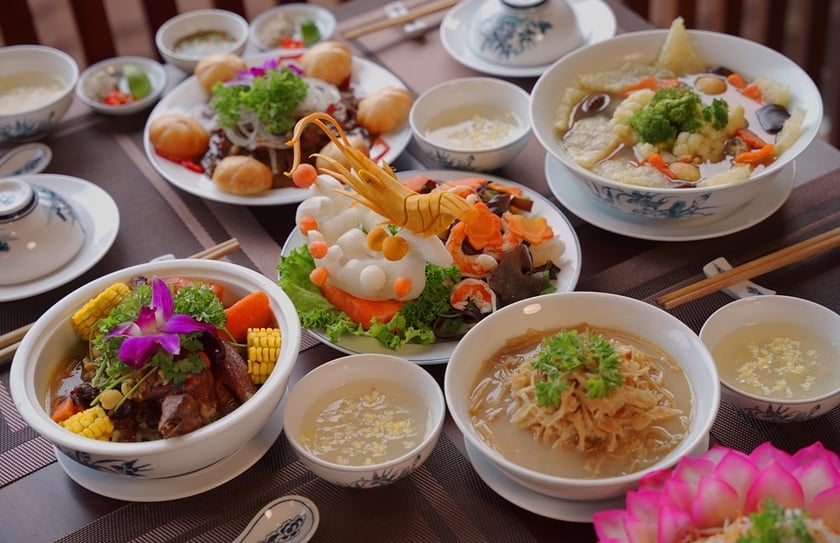
Bat Trang dishes - culinary quintessence imbued with Vietnamese flavor
Despite the difference in quantity, the traditional Tet tray of Bat Trang village still cannot lack popular dishes, imbued with the flavor of Vietnamese Tet such as a plate of golden fried spring rolls, a boiled chicken with shiny skin, a plate of sparkling stir-fried vermicelli, a bowl of fragrant stewed pigeon, slices of smooth white pork sausage, square green banh chung, fragrant cinnamon sausage and a bowl of elegant soup. However, what makes the tray of food here unique is the presence of dishes bearing the mark of the craft village and the land along the Red River.

Bat Trang dishes bring together many delicious dishes, meticulously prepared by the skillful hands of the people of the famous pottery village for generations.
One of the indispensable "souls" of the Bat Trang tray is the pigeon spring rolls. Completely different from the usual spring rolls, the pigeon spring rolls bring a delicate, nutritious and attractive flavor. To create this special spring roll, the chef must carefully select young pigeons with soft and naturally sweet meat. The minced pigeon meat will be mixed with fresh diced vegetables such as carrots, kohlrabi, wood ear mushrooms, shiitake mushrooms, along with egg yolks and traditional spices seasoned according to a family secret. The spring roll wrapping process also requires skill and meticulousness to create small, bite-sized spring rolls, with a thin rice paper crust that, when fried, will turn golden brown and melt in your mouth.

The meticulousness and skill are reflected in the spring rolls.
In addition, the shrimp cake in Bat Trang's tray is a testament to the creativity and skillful combination of ingredients of the local people. Fresh shrimps, caught from the river area around the village, will be pounded or ground, then seasoned to taste and shaped into round or long pieces, depending on the homeowner's preference. The special thing that can make the difference of Bat Trang shrimp cake is the skillful addition of a little chopped betel leaves to the mixture. When these pieces of cake are grilled over charcoal, the strong, characteristic aroma of betel leaves will spread, mixed with the seductive aroma of golden-cooked shrimp.
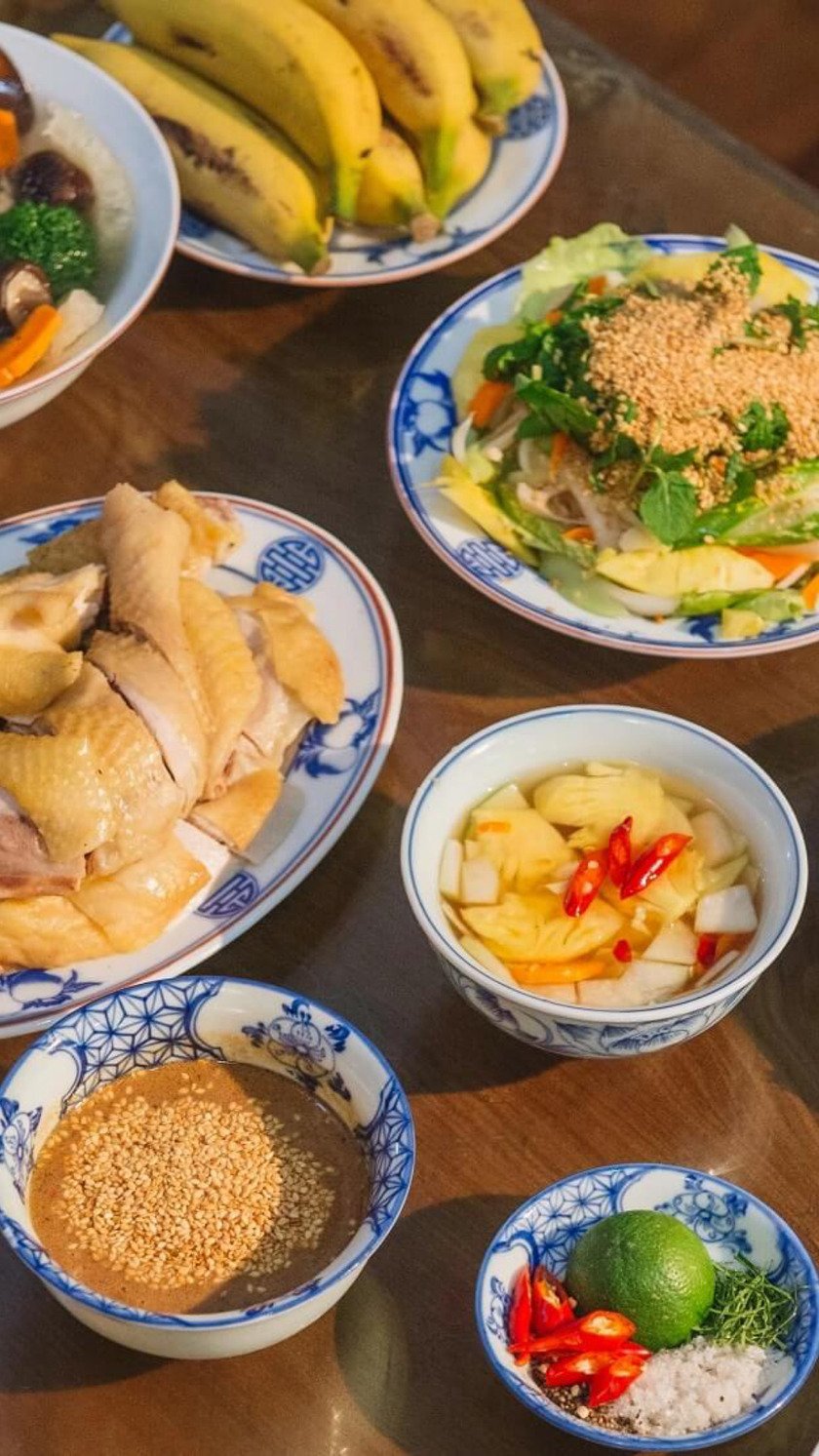
Boiled chicken seems to be an indispensable part of any traditional Vietnamese feast, and the Bat Trang feast is no exception. However, the boiled chicken in the feast here is usually small, carefully selected chickens to ensure firm, fragrant meat and a natural yellow color. The secret to having a beautiful and delicious boiled chicken dish lies not only in the quality of the chicken but also in the boiling technique to cook it just right, so that the chicken skin is golden yellow, shiny, and not torn. When cutting, the chicken pieces must be even, arranged so that the whole chicken is still intact, showing respect for the dish and the diners.
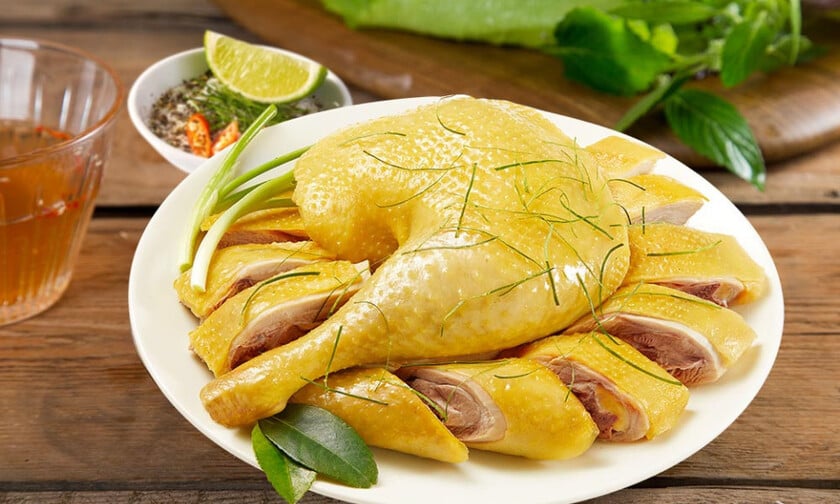
Boiled chicken dish seems simple but it requires a lot of effort.
The uniqueness of Bat Trang cuisine is also shown through the dish of stir-fried squid with kohlrabi. The best dried squid is grilled on a charcoal stove to create a characteristic aroma, then torn into bite-sized pieces. Fresh kohlrabi is peeled, cut into bite-sized pieces, and quickly stir-fried over high heat to retain its natural crispiness and sweetness. In particular, on New Year's Day, the stir-fried squid with kohlrabi dish can be replaced with a plate of roasted almonds, symbolizing luck and prosperity.
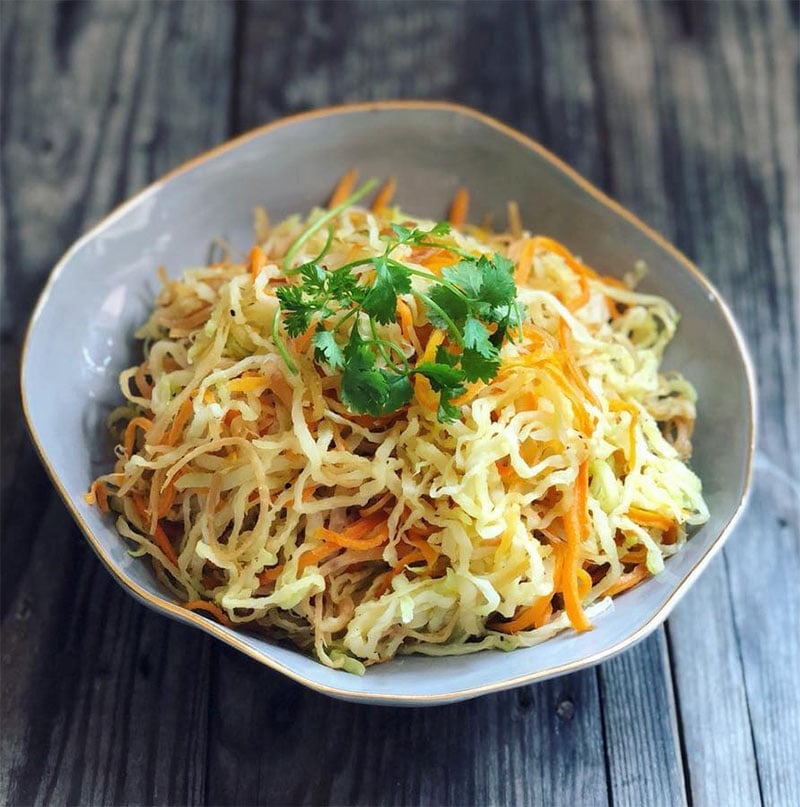
Stir-fried dried squid with kohlrabi

Sticky rice is a familiar dish in traditional Vietnamese cuisine, but in Bat Trang, it has a special meaning, symbolizing fullness and prosperity. Sticky rice is usually steamed from yellow sticky rice, a type of sticky rice with large, round grains, fragrant and fragrant, typical of the Northern Delta. After being steamed until soft, green beans will be ground finely, then stir-fried with sugar until fluffy, creating a golden layer covering the pure white sticky rice grains. When enjoying, people will rub the sticky rice with green beans, creating loose, sticky rice balls with an attractive yellow color and the strong aroma of new sticky rice mixed with the fatty taste of green beans, creating a simple dish but rich in traditional flavor, often eaten with sweet soup or cau flower sweet soup, creating a perfect pair for a spring party.
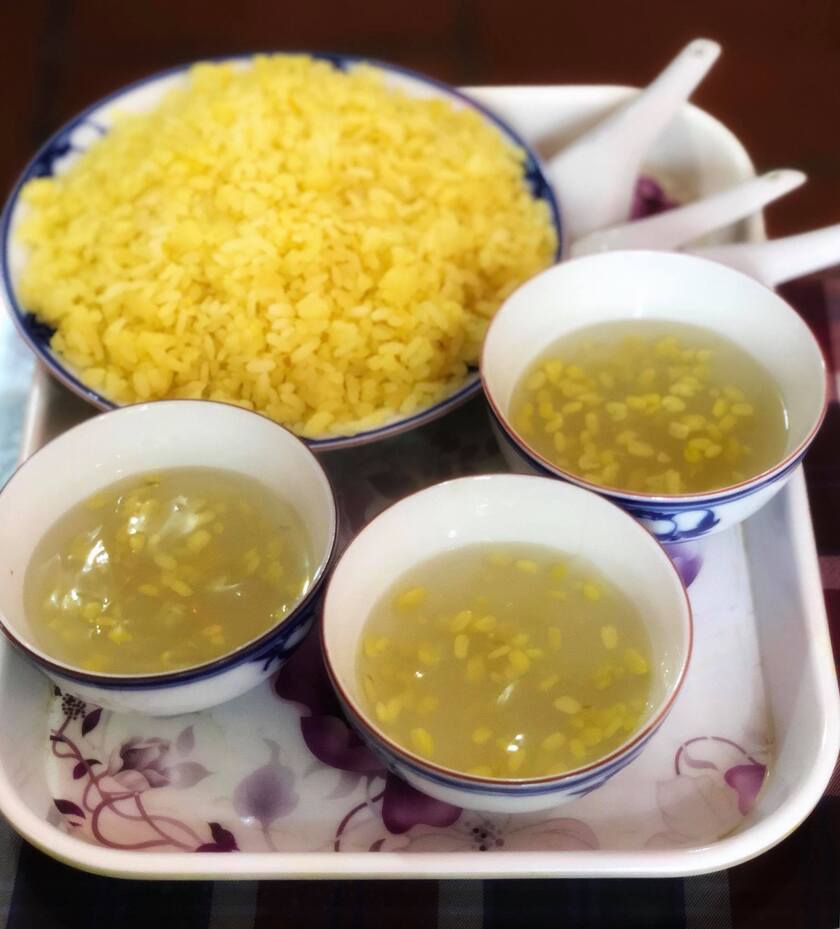
Sticky rice is indispensable on the traditional Vietnamese tray.
Finally, the squid bamboo shoot soup is perhaps the most local dish on the Bat Trang tray, reminiscent of the gentle Red River and the products of this land. The dried bamboo shoots are carefully selected, such as bamboo shoots or pig tongue shoots, then boiled until soft and then shredded into bite-sized pieces. The dried squid is also grilled over charcoal to enhance the delicious flavor and then shredded. The broth of this soup is usually simmered from pork or chicken bones, bringing a natural sweetness.

Bamboo shoot and squid soup in traditional dishes
Traditional culture in every bite
Despite the discussion about the somewhat expensive price, Bat Trang dishes still confidently assert their special appeal, attracting countless diners to come and fully enjoy the uniqueness and traditional values hidden in each dish.
To recreate a Bat Trang tray of dishes according to ancient customs, the chef is not only a cook but also an artisan, having to go through a meticulous and meticulous preparation process down to every detail. From the selection of the freshest, seasonal ingredients, to the preparation and processing of each dish, it requires the skillful hands of talented people, the extensive experience accumulated over many generations, and above all, a heart full of love for each flavor. Each dish on the tray has its own secrets, from the delicate marinade to bring out the characteristic aroma, skillful processing techniques to preserve the natural sweetness of the ingredients, to the harmonious and beautiful presentation, stimulating all the senses of the diner.

Despite many controversies about its value, Bat Trang dishes still attract many diners to enjoy.
Amidst the hustle and bustle of modern life, where traditional values are sometimes at risk of fading, Bat Trang dishes still firmly maintain their position, becoming a beautiful and valuable culinary culture symbol of Hanoi. It is not simply a meal to satisfy the taste buds, but also a journey back in time, taking diners to discover ancient flavors, culinary quintessence distilled through many generations.
Enjoying a Bat Trang feast is a profound cultural experience, showing respect for the past, pride in the good traditional values of our ancestors, and is a link connecting generations in the family and community, together enjoying the flavors of the homeland, of the thousand-year-old cultural identity of Thang Long - Hanoi.






